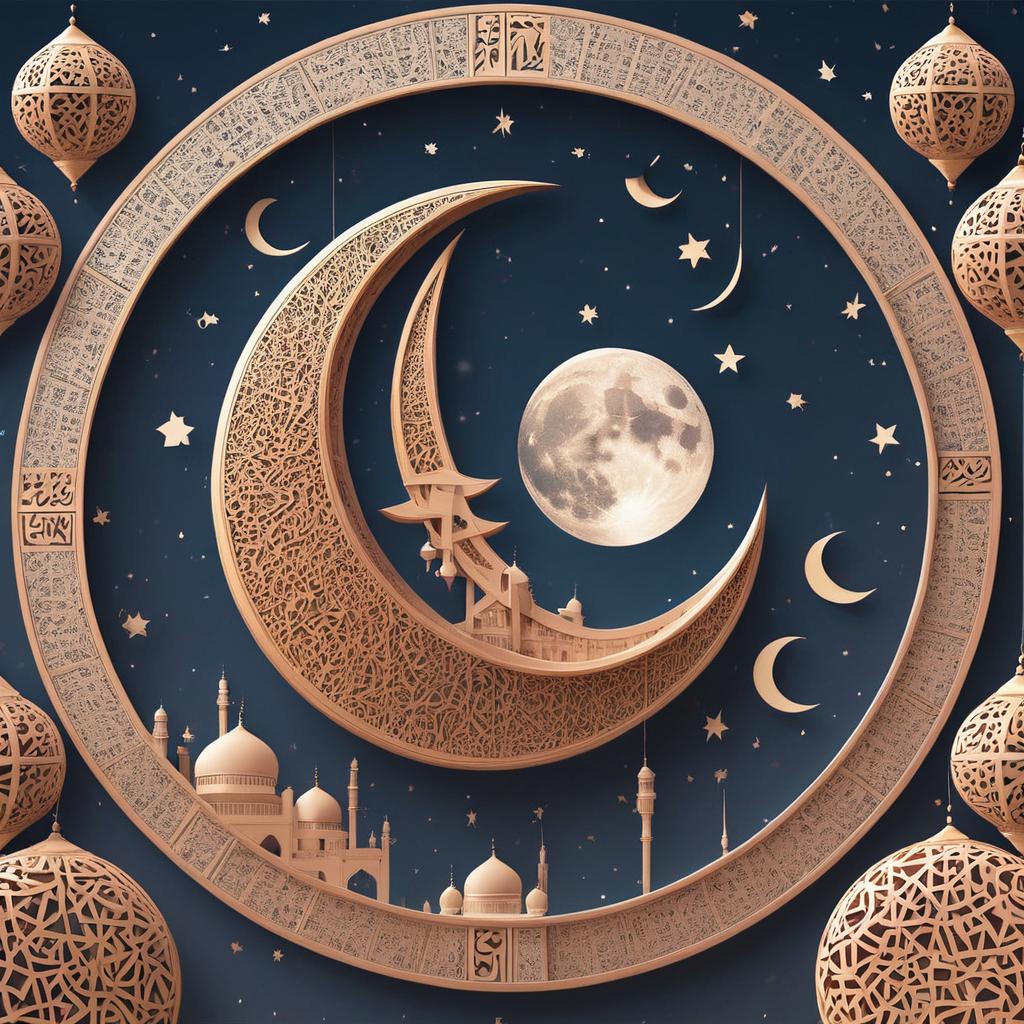Eid al-Fitr and Lunar Calendar: Understanding Significance

As the sacred month of Ramadan nears its end, Muslims worldwide eagerly anticipate the joyous occasion of Eid al-Fitr. This significant festival marks the culmination of a month-long period of fasting, prayer, and spiritual reflection. Central to the determination of Eid al-Fitr’s timing is the sighting of the new moon, an essential aspect of the Islamic lunar calendar. However, this year presents a unique scenario, as the occurrence of a total solar eclipse intersects with the traditional methods of moon sighting, prompting discussions and adjustments in the observance of this cherished festival.
Essence of Ramadan and Eid al-Fitr: Fasting, Faith, and Celebration
Ramadan holds a central place in the hearts of Muslims worldwide. It is a month of devotion, self-discipline, and community solidarity. From dawn to sunset, believers abstain from food, drink, and other physical needs, redirecting their focus towards spiritual growth, prayer, and acts of charity. The culmination of this month-long period of spiritual dedication is marked by Eid al-Fitr, a celebration of gratitude, joy, and communal bonds.
Traditions and Customs Surrounding Eid al-Fitr
Eid al-Fitr, often referred to as the “Festival of Breaking the Fast,” carries rich traditions and customs that vary across different cultures and regions. Preparations for Eid typically begin with the observation of the last days of Ramadan, where Muslims intensify their prayers and supplications, seeking forgiveness and spiritual fulfillment. As the crescent moon marks the end of Ramadan and the beginning of Shawwal, the tenth month of the Islamic lunar calendar, communities come together to celebrate Eid with prayers, feasting, and acts of generosity.
Role of the Lunar Calendar in Determining Eid al-Fitr
The Islamic calendar, also known as the Hijri or lunar calendar, relies on the sighting of the moon to determine the start and end of lunar months. Eid al-Fitr, like other Islamic festivals, follows this lunar calendar, making the sighting of the new moon crucial in establishing the beginning of Shawwal and the commencement of Eid celebrations. Traditionally, Muslim communities gather to observe the sky on the 29th day of Ramadan, eagerly awaiting the first sighting of the crescent moon, which signals the end of fasting and the onset of Eid festivities.
Solar Eclipse Conundrum: An Unforeseen Celestial Event
In the year 2024, the observance of Eid al-Fitr encounters an unexpected celestial phenomenon: a total solar eclipse. While solar eclipses are rare occurrences, their impact on traditional methods of moon sighting is significant. The brilliance of the sun during a solar eclipse makes it challenging to observe the faint crescent moon, typically visible at the end of the lunar month. This intersection of celestial events raises questions and considerations regarding the determination of Eid al-Fitr and the continuity of established practices in the Muslim world.
Navigating the Solar Eclipse and Moon Sighting: Challenges and Solutions
The total solar eclipse on April 8, 2024, presents both challenges and opportunities for Muslim communities seeking to observe the new moon for Eid al-Fitr. While the eclipse offers a rare chance to view the outline of the new moon with the aid of eclipse glasses, its occurrence complicates the traditional process of moon sighting. In regions where the solar eclipse is visible, observers may struggle to differentiate between the sun’s glare and the subtle crescent moon, posing a challenge to accurate moon sighting.
Adaptations and Adjustments: Innovations in Moon Sighting
In response to the unique circumstances posed by the solar eclipse, Muslim scholars and communities have proposed adaptations and adjustments to facilitate the accurate determination of Eid al-Fitr. One approach involves leveraging advancements in technology, such as astronomical calculations and computer simulations, to predict the visibility of the new moon amidst the solar eclipse’s glare. Additionally, efforts to coordinate moon sighting observations across multiple locations and time zones aim to enhance the accuracy and reliability of determining Eid al-Fitr.
Maintaining Unity and Solidarity: The Spirit of Eid al-Fitr
Amidst the complexities of celestial events and lunar calculations, the essence of Eid al-Fitr remains rooted in unity, solidarity, and communal spirit. While the methods of moon sighting may evolve in response to changing circumstances, the core values of gratitude, compassion, and generosity that define Eid endure. Muslim communities worldwide strive to uphold these values, fostering bonds of kinship and compassion as they come together to celebrate the culmination of Ramadan and the blessings of Eid al-Fitr.
Looking Ahead: Embracing the Spirit of Adaptation and Resilience
As the solar eclipse casts its shadow across the skies, Muslim communities navigate the intricacies of moon sighting with a spirit of adaptation and resilience. While the convergence of celestial events may present challenges, it also offers an opportunity for reflection, innovation, and unity. As Muslims around the world await the confirmation of Eid al-Fitr, they do so with a steadfast commitment to the principles of faith, community, and gratitude that define this auspicious occasion. In the face of uncertainty, the spirit of Eid al-Fitr shines brightly, illuminating hearts with hope, joy, and the promise of renewal.
Also Read: Ramadan Fasting 2024: What to Eat During Suhoor/Suhur
Q: How is Eid al-Fitr traditionally determined?
A: Eid al-Fitr is traditionally determined by the sighting of the new moon, which marks the end of Ramadan and the beginning of the month of Shawwal in the Islamic lunar calendar.
Q: How does the sighting of the new moon impact the observance of Eid al-Fitr?
A: The sighting of the new moon is crucial in establishing the timing of Eid al-Fitr. Once the crescent moon is sighted, it signifies the end of fasting during Ramadan and the onset of Eid celebrations, which typically last for three days.
Q: What role does the lunar calendar play in determining Eid al-Fitr?
A: Eid al-Fitr, like other Islamic festivals, follows the lunar calendar, known as the Hijri calendar. This calendar relies on the sighting of the moon to determine the beginning and end of lunar months, including Ramadan and Shawwal.
Q: How does the occurrence of a total solar eclipse impact the observation of Eid al-Fitr?
A: The occurrence of a total solar eclipse presents challenges in moon sighting, as the brilliance of the sun during the eclipse makes it difficult to observe the faint crescent moon typically visible at the end of Ramadan. This intersection of celestial events prompts discussions and adjustments in the determination of Eid al-Fitr.
Q: What adaptations are being considered to facilitate moon sighting during a solar eclipse?
A: Muslim scholars and communities are exploring various adaptations, including leveraging technological advancements such as astronomical calculations and coordinating moon sighting observations across multiple locations and time zones, to enhance the accuracy and reliability of determining Eid al-Fitr amidst the solar eclipse’s glare.
Also Read: Great Tips for Healthy Eating during Ramadan 2024
Q: How do Muslim communities maintain unity and solidarity during the observation of Eid al-Fitr?
A: Despite the complexities of moon sighting and celestial events, Muslim communities uphold the values of unity, solidarity, and communal spirit during Eid al-Fitr. Through acts of gratitude, compassion, and generosity, they come together to celebrate the blessings of Ramadan and the joy of Eid al-Fitr, fostering bonds of kinship and compassion.











